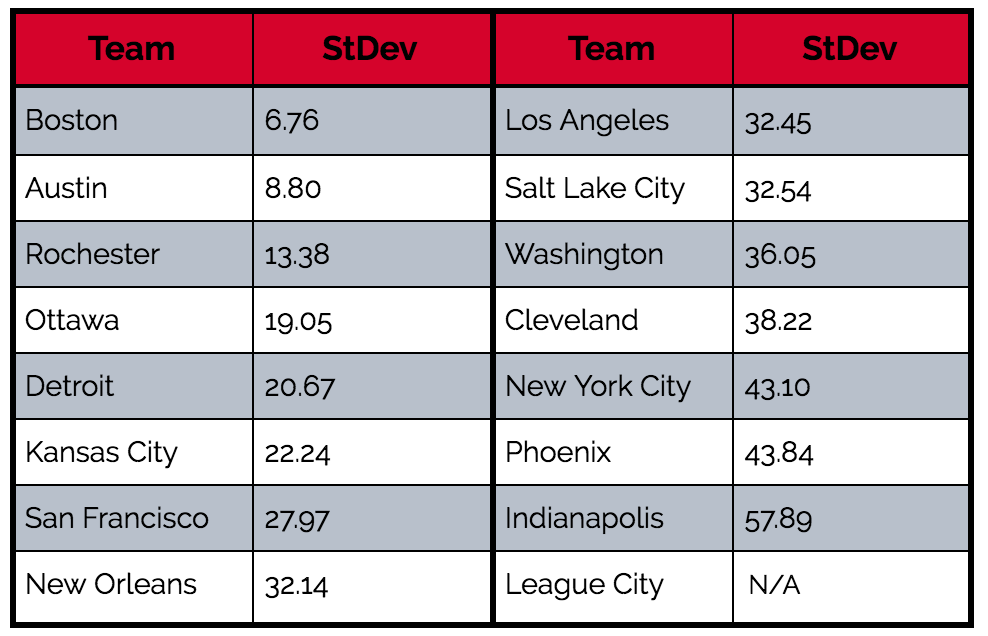By Joshua Mansfield
Statistics Coordinator
This season, thanks to a dedicated group of team volunteers, we are privy to the fastest stat turnaround rate the league has ever seen. With this in place, the statistics we see have transformed from being merely season-to-season records to be kept to tools to be used for analytical purposes. Stats may not be able to tell the whole story, but their perspective gives us a fresh angle to observe the league from–one that incorporates more objective data than an initial glance might give.
For beaters, one of the deeper looks this season will be a “Points Above Replacement” analysis. This metric will serve as a rough look at which beaters are outperforming (and underperforming) their team’s average goal scoring rate and how they compare to the average beater on their team. A simple way of doing this is by looking at a beater’s plus/minus (+/-) rating (the sum of points scored on a beater’s team while they’re on the pitch subtracted from the sum of points that beater’s team scores while on pitch) divided by the amount of drives they play, to find their “Plus/Minus Per Drive” (PMPD). For example, if a beater plays five drives, and their team scores on three of them and is scored on once, their PMPD would be (30-10)/5 or 4. While this metric is better than just pure +/-, it fails to control for the strength of the chasers and keepers on a beater’s team. On a team with dominant chasers, even an average beater will appear to have a good PMPD, while a great beater’s PMPD may appear to be mediocre when put on a team whose quaffle game is significantly outmatched. To account for this, we can compare a beater’s PMPD for a series against their team’s PMPD for that series, to get the “Comparative Plus/Minus” (Comp. +/-) stat. For example, if a beater is getting scored on every three drives on average (-3.33 PMPD) but their team is scored on every other drive on average (-5.0 PMPD), then that beater’s Comp. +/- would be +1.67. Meaning that compared to the rest of their team, that beater’s team scores 1.67 points more, on average, when that beater is on the pitch. Taking this one step further, we can determine how much of a benefit that beater was to their team in total, by multiplying their Comp. +/- by the amount of drives they played. This gives us that beater’s “Points Above Replacement” (PAR) – in other words, how many points for or against a team a beater was responsible for during their play. Expressed in formula, PAR is as follows:

While useful, PAR is by no means a perfect measurement of a beater’s skill, as it relies almost entirely on +/- to take its value. While in general, a beater’s main job should be to increase the amount of goals their team scores while limiting those that are scored on them, this metric can be over or under-inflated by snitch on pitch play, when scoring rates tend to fluctuate wildly. Furthermore, a beater’s +/- can be over or underinflated based on their beating partner. This is less of an issue for teams who fluidly rotate their beaters and maximize the number of beater combinations their team fields. However, teams who utilize standardized beater rotations (e.g. one beater always plays with a certain partner) may see a beater’s +/- inflated if they are always on pitch with a talented partner, or deflated if they are always on pitch with a below average partner.
Most importantly, PAR is an entirely team-dependent metric, as the disparity of average beater skill from one team to the next can fluctuate dramatically. If a team’s beaters are all at a relatively similar skill level, their PARs should all be relatively close to 0. That isn’t a bad thing, and in fact, likely means the team is using its beaters at a relatively optimal level. A team whose beaters are all relatively talented will likely only see large disparities in PAR if they are using a beater too much or too little. If a beater’s PAR is high, it likely means that beater should have played more drives, until their average and the team’s average converged. Conversely, if a beater’s PAR is significantly negative, it likely means they played too many drives and were either too tired or significantly worse than the other beaters on their team to maintain their team’s average scoring rate.
Because of this, this metric not only shows us which beaters outperformed their teams, but also which teams used their beaters most efficiently. In theory, a perfectly efficient team should play their beaters with higher PAR until their PAR converges to 0–either due to them pulling up the team’s average PMPD to their own or due to their average PMPD dropping due to fatigue. In an idealized scenario, the PAR of every beater on a team should be 0 or as close to it as possible, meaning that the best beaters were played to their maximum such that their subs could replace them and play as well as them, on average. By looking at the standard deviations of each team’s PAR for their first series, we can get a view for which teams managed their beater substitutions most ideally.

Note: Beater metrics from League City were not available upon publication due to the current unavailability of beater statistics from their team.
Presented here is a table of each beater’s PMPD, Comp. +/- and PAR for their team’s first series. This table and beater’s PAR values will continue to be tracked throughout the course of the season.

